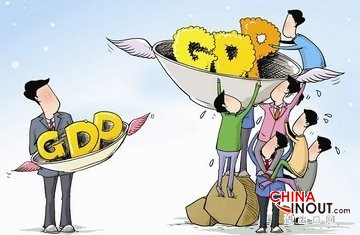中國(guó)人民銀行在本周三發(fā)布的工作文件中稱(chēng),,明年中國(guó)經(jīng)濟(jì)的年增長(zhǎng)率將由今年預(yù)計(jì)的6.9%下跌至6.8%。
央行在研究報(bào)告中提到,,世界第二大經(jīng)濟(jì)體仍然面臨著下行壓力,,并且今年鋪展開(kāi)的財(cái)政和貨幣政策會(huì)在2016年上半年會(huì)逐漸顯現(xiàn)效果。
報(bào)告原文說(shuō):“盡管由產(chǎn)能過(guò)剩,、利潤(rùn)減速,、不良貸款增加等因素引起的增長(zhǎng)下行壓力還將持續(xù)一段時(shí)間,我們期望有利因素的數(shù)目會(huì)在2016年逐漸增加,。”
央行報(bào)告稱(chēng),,最近的人民幣實(shí)際有效匯率的增值給中國(guó)出口帶來(lái)壓力;并補(bǔ)充說(shuō)保持人民幣貿(mào)易加權(quán)兌換率相對(duì)穩(wěn)定有利于出口增長(zhǎng),。
同時(shí),,政府頂級(jí)智囊團(tuán)中國(guó)社科院在其藍(lán)皮書(shū)中預(yù)測(cè),由于外部需求疲軟以及國(guó)內(nèi)投資降溫,,2016年經(jīng)濟(jì)增長(zhǎng)會(huì)更加緩慢,,增速徘徊在6.6%到6.8%之間。
中科院建議中國(guó)政府在明年應(yīng)該將財(cái)政赤字由原計(jì)劃的1.62萬(wàn)億元擴(kuò)大到2.12萬(wàn)億元,,使其在警戒水平3%之內(nèi)與GDP持平,。
中科院的經(jīng)濟(jì)學(xué)家李雪松在新聞發(fā)布會(huì)上說(shuō):“在經(jīng)濟(jì)面臨下行和通縮壓力之際,中國(guó)很有必要增加財(cái)政政策的力度,。”
上月,,中國(guó)財(cái)政部副部長(zhǎng)朱光耀說(shuō)全世界的經(jīng)濟(jì)學(xué)家們應(yīng)該重新考慮究竟是什么組成了赤字占GDP比率的危險(xiǎn)地帶。在評(píng)論中,,有些分析員認(rèn)為這些話是更加激進(jìn)的刺激手段的先兆,。
自全球經(jīng)濟(jì)危機(jī)邁入嚴(yán)峻階段,中國(guó)政府已經(jīng)釋放出最激進(jìn)的政策,。其中包括自2014年11月來(lái)的六次下調(diào)利率來(lái)下注刺激今年的經(jīng)濟(jì)增長(zhǎng)目標(biāo)保持在7%左右,。
由央行首席經(jīng)濟(jì)學(xué)家馬俊和其他央行經(jīng)濟(jì)學(xué)家撰寫(xiě)的報(bào)告提到,在產(chǎn)權(quán)投資逐漸趨于穩(wěn)定之際,,央行期望中國(guó)的固定資產(chǎn)能夠自今年起在2016年增長(zhǎng)10.8%,。固定資產(chǎn)額是國(guó)家經(jīng)濟(jì)關(guān)鍵驅(qū)動(dòng)力之一。
報(bào)告稱(chēng),,作為國(guó)內(nèi)消費(fèi)的關(guān)鍵衡量指標(biāo),,中國(guó)的零售銷(xiāo)售額在明年能夠?qū)崿F(xiàn)增長(zhǎng)11.1%的年增長(zhǎng)率,。
央行在預(yù)測(cè)中提到,2016年,,中國(guó)年出口額預(yù)計(jì)會(huì)上升3.1%,,而進(jìn)口額會(huì)上升2.3%。
有別于今年預(yù)測(cè)的1.5%,,2016年中國(guó)的年度通貨膨脹會(huì)加速上升至1.7%,;而生產(chǎn)價(jià)格指數(shù)則預(yù)計(jì)會(huì)下跌1.8%,較2015年預(yù)測(cè)的5.2%下跌較緩,。(中國(guó)進(jìn)出口網(wǎng))
China's annual economic growth is likely to slow to 6.8 percent next year from an expected 6.9 percent this year, the People's Bank of China said in a working paper published on Wednesday.
The world's second-largest economy still faces downward pressure and the impact of fiscal and monetary policies that were rolled out this year will be evident by the first half of 2016, the central bank said in the research report.
"Although downward pressures on growth will persist for a while due to overcapacity, profit deceleration, and rising non-performing loans, we expect that the number of positive factors will gradually increase in 2016," it said.

Recent appreciation in the yuan's real effective exchange rate (REER) has put pressure on China's exports, the central bank report said, adding that keeping the yuan's trade-weighted exchange rate relatively stable could help exports.
Meanwhile, the Chinese Academy of Social Sciences (CASS), a top government think tank, predicted in its "blue book" the economy could expand at a slower pace between 6.6 percent and 6.8 percent in 2016 due to weak external demand and cooling domestic investment.
The think tank recommended that China should widen its fiscal deficit to 2.12 trillion yuan ($327.6 billion) next year from a planned 1.62 trillion yuan in 2015, keeping the deficit to GDP ratio within the warning level of 3 percent.
"It's quite necessary for China to increase strength on its fiscal policy as the economy faces downward and deflation pressure," said Li Xuesong, an economist at CASS, told a media conference.
China's Vice Finance Minister Zhu Guangyao said last month that economists the world over should reconsider what constitutes a danger zone for deficit-to-GDP ratios, in comments that some analysts took as a hint of more aggressive stimulus to come.
The government has embarked on its most aggressive policy easing since the depths of the global financial crisis, including six interest rate cuts since November 2014, in a bid to hit its economic growth target of around 7 percent this year.
The central bank expects China's fixed-asset investment, a key driver of the economy, to grow 10.8 percent in 2016 from this year, as property investment gradually stablises, according to the report written by Ma Jun, the bank's chief economist, and other central bank economists.
China's retail sales, a key gauge of domestic consumption, could grow an annual 11.1 percent next year, it said.
China's exports are expected to rise an annual 3.1 percent in 2016 while imports are forcast to grow 2.3 percent, the PBOC said in its projections.
China's annual consumer inflation may quicken to 1.7 percent in 2016 from an expected 1.5 percent this year. The producer price index is forecast to fall 1.8 percent in 2016, moderating from an expected 5.2 percent drop in 2015.











